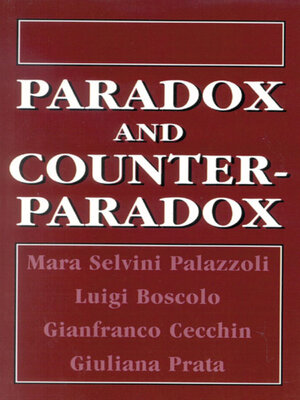Paradox and Counterparadox
ebook ∣ A New Model in the Therapy of the Family in Schizophrenic Transaction · Historical Dictionaries of Intelligence and Counterintelligence
By Mara Selvini Palazzoli

Sign up to save your library
With an OverDrive account, you can save your favorite libraries for at-a-glance information about availability. Find out more about OverDrive accounts.
Find this title in Libby, the library reading app by OverDrive.



Search for a digital library with this title
Title found at these libraries:
| Library Name | Distance |
|---|---|
| Loading... |
Paradox and Counterparadox introduces the English-speaking public to the first results of a research plan drawn up my the Milan Center for Family Studies at the end of 1971 and put into practice at the beginning of 1972. The book reports the therapeutic work carried out by the authors with fifteen families, five with children presenting serious psychotic disturbances, and ten with young adults diagnosed as schizophrenics in acute phase. Though accepting the Bleulerian term schizophrenia, by now in general use, the authors have used it to indicate not the sickness of an individualDas in the traditional medical modelDbut a peculiar pattern of communication inseparable from the other patterns of communication observable in the natural group (in this case, the family) in which it manifests itself. Starting from the position that modern sciences concerned with communication emphasize the central role of paradox as the source of paralyzing disturbances as well as of creative transformations, the authors demonstrate that it is possible to intervene in a family in schizophrenic transaction by devising original and paradoxical methods in order to release the action-pattern from disturbance to transformation. The counterparadoxes generated in this process, illustrated through a great number of examples, are rigorously analyzed in accordance with the conceptual models provided by general systems theory, by cybernetics, and by the pragmatics of human communication. The reader will recognize, in the cases presented, the stimulating originality and efficacy of this approach, one whose interest exceeds the purely clinical and which offers new points of departure for an ecologic vision of human relationships. A Jason Aronson Book







